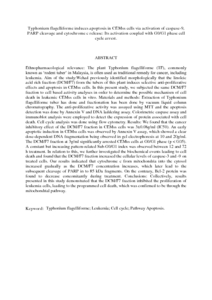Citation
Mohan, Syam and Abdul, Ahmad Bustaman and Abdelwahab, Siddig Ibrahim and Al-Zubairi, Adel Sharaf and Sukari, Mohamed Aspollah and Abdullah, Rasedee and Elhassan Taha, Manal Mohamed and Ibrahim, Mohamed Yousif and Syam, Suvitha
(2010)
Typhonium flagelliforme induces apoptosis in CEMss cells via activation of caspase-9, PARP cleavage and cytochrome c release: Its activation coupled with G0/G1 phase cell cycle arrest.
Journal of Ethnopharmacology, 131 (3).
pp. 592-600.
ISSN 0378-8741
Abstract
Ethnopharmacological relevance: The plant Typhonium flagelliforme (TF), commonly known as ‘rodent
tuber’ in Malaysia, is often used as traditional remedy for cancer, including leukemia.
Aim of the study:Wehad previously identified morphologically that the linoleic acid rich fraction (DCM/F7)
from the tubers of this plant induces selective anti-proliferative effects and apoptosis in CEMss cells. In
this present study, we subjected the same DCM/F7 fraction to cell based activity analyses in order to
determine the possible mechanism of cell death in leukemic CEMss cells in vitro.
Materials and methods: Extraction of Typhonium flagelliforme tuber has done and fractionation has been
done by vacuum liquid column chromatography. The anti-proliferative activity was assayed using MTT
and the apoptosis detection was done by Annexin V and DNA laddering assay. Colorimetric caspase assay
and immunoblot analysis were employed to detect the expression of protein associated with cell death.
Cell cycle analysis was done using flow cytometry.
Results: We found that the cancer inhibitory effect of the DCM/F7 fraction in CEMss cells was
3±0.08g/ml (IC50). An early apoptotic induction in CEMss cells was observed by Annexin V assay,
which showed a clear dose-dependent DNA fragmentation being observed in gel electrophoresis at 10
and 20g/ml. The DCM/F7 fraction at 3g/ml significantly arrested CEMss cells at G0/G1 phase (p < 0.05).
A constant but increasing pattern-related Sub-G0/G1 index was observed between 12 and 72 h treatment.
In relation to this, we further investigated the biochemical events leading to cell death and found that the
DCM/F7 fraction increased the cellular levels of caspase-3 and -9 on treated cells. Our results indicated
that cytochrome c from mitochondria into the cytosol increased gradually as the DCM/F7 concentration
increases, which later lead to the subsequent cleavage of PARP in to 85 kDa fragments. On the contrary,
Bcl-2 protein was found to decrease concomitantly during treatment.
Conclusions: Collectively, results presented in this study demonstrated that the DCM/F7 fraction inhibited
the proliferation of leukemia cells, leading to the programmed cell death, which was confirmed to be
through the mitochondrial pathway.
Download File
![[img]](http://psasir.upm.edu.my/9455/1.hassmallThumbnailVersion/Typhonium%20flagelliforme%20induces%20apoptosis%20in%20CEMss%20cells%20via%20activation%20of%20caspase.pdf)  Preview |
|
PDF (Abstract)
Typhonium flagelliforme induces apoptosis in CEMss cells via activation of caspase.pdf
Download (188kB)
| Preview
|
|
Additional Metadata
Actions (login required)
 |
View Item |

